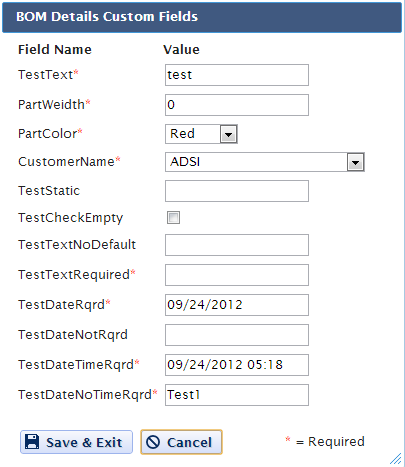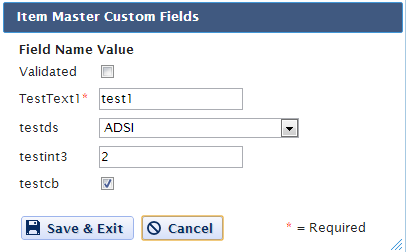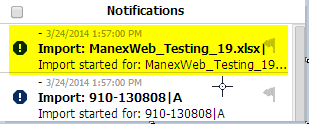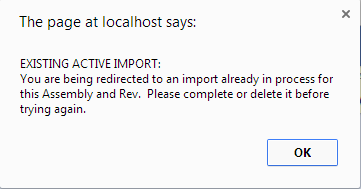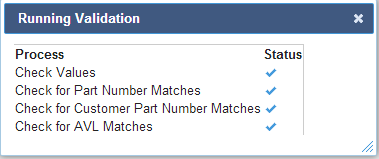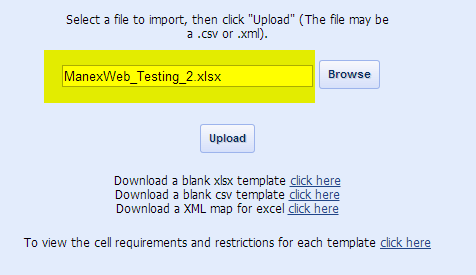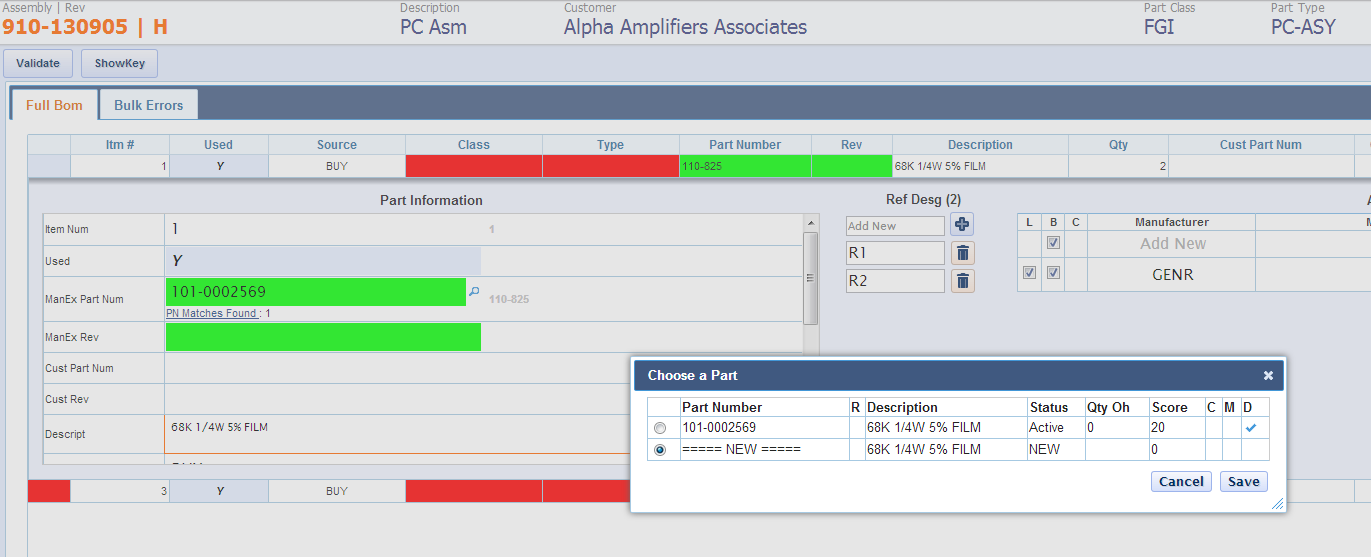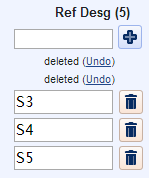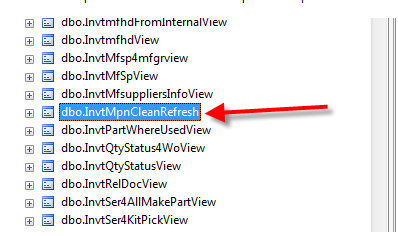| 1. Product Data Management |
| 1.1. Bill of Material |
| 1.1.1. Introduction |
|
ADDRESS {rootURL} orders
NOTE: {rootURL} is the URL you use to access web ManEx
AVAILABLE ACTIONS From this screen, the user can:
|
| 1.1.2. Fields and Definitions |
Bill of Material - Standard
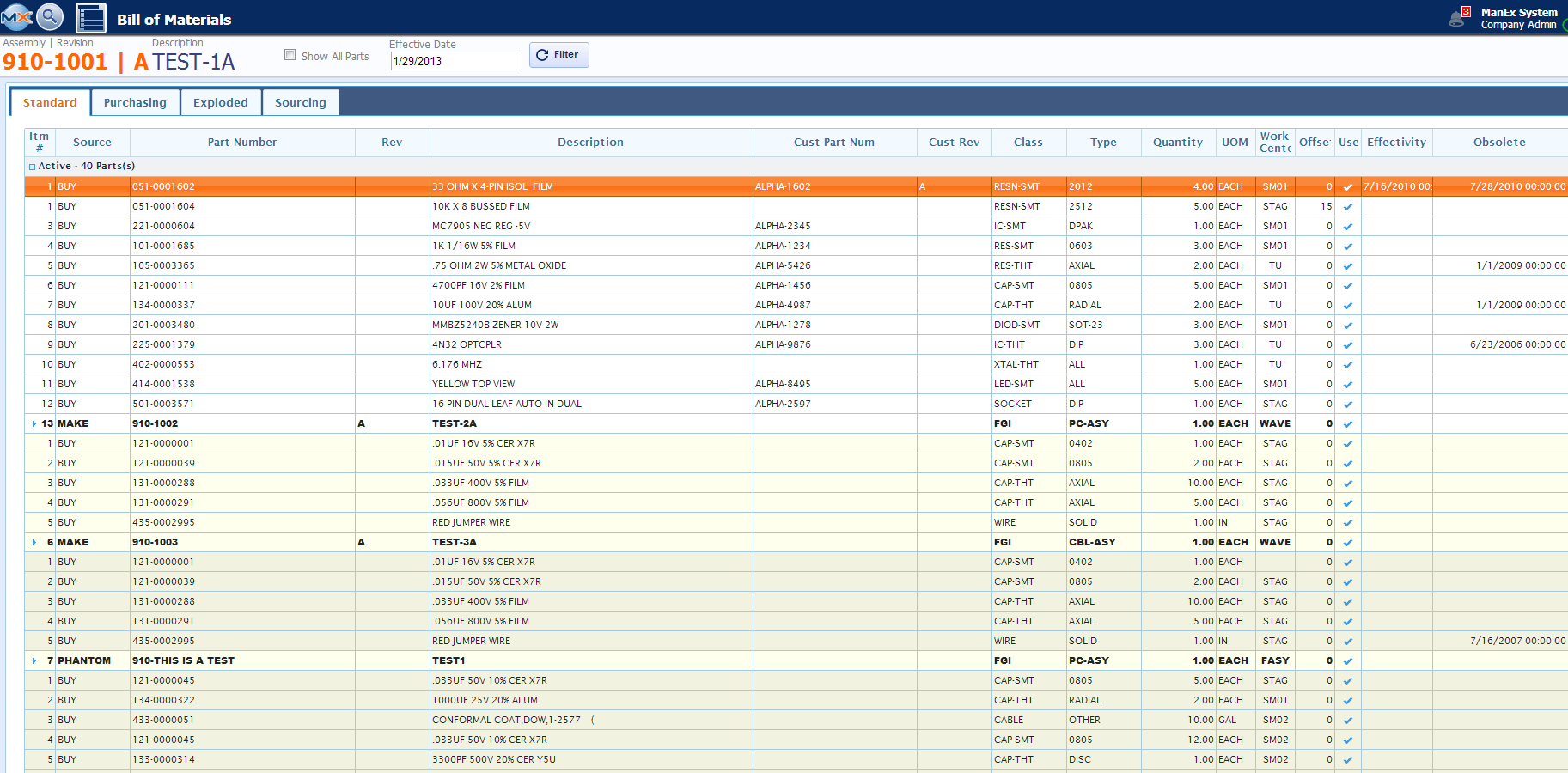 Itm# - The item number assigned to the components in the BOM.
Part Number - The components internal Manex part number
Rev - The Part Number Revision for the component. A component may exist under multiple revisions. Each Rev. is considered a unique part number and may co-exist with other Revs. or replace other Revs
Source - The sources of the assembly components. Select Make, Buy, Consigned or Phantom
Description - The Item Master description of the component part.
Cust Rev - The Part Number Revision for the component. A component may exist under multiple revisions. Each Rev. is considered a unique part number and may co-exist with other Revs. or replace other Revs
Class - The Part Class of the component part as assigned in the Item Master
Type - The Part Type of the component part as assigned in the Item Master
Quantity - The quantity of the component part used in the assembly. This qty does NOT compensate for setup and run losses; The Setup % and Run Qty fields in the Item Master screen cover production losses
UOM - The stocking/kitting unit of measure for the part
Work Center - The work center identified in the routing for the assembly at which the part is needed. Kitting of the part by work center will use this information to determine which parts are to be kitted for each work center
Offset - Production offset is a BoM item level field that allows users to control delivery dates in relation to the starting date of the work order. By using this field, the user may move the material requirement date by the specified number of days in either direction
Used - Identifies the part as requiring kitting from the storeroom. Typical Non-kitted items include chemicals and adhesives that are re-issued when they run low but are included on the BOM for costing or reference
Effectively - This is the date that the part is added and/or removed from the BOM and the demands will be displayed in MRP. MRP picks up all the records with an effective date earlier or equal to current date, and all NULL/BLANK effective dates
Obsolete - The date the part is no longer required on the BOM for new work orders and the demands will NOT be displayed in MRP
Bill of Material - Purchasing
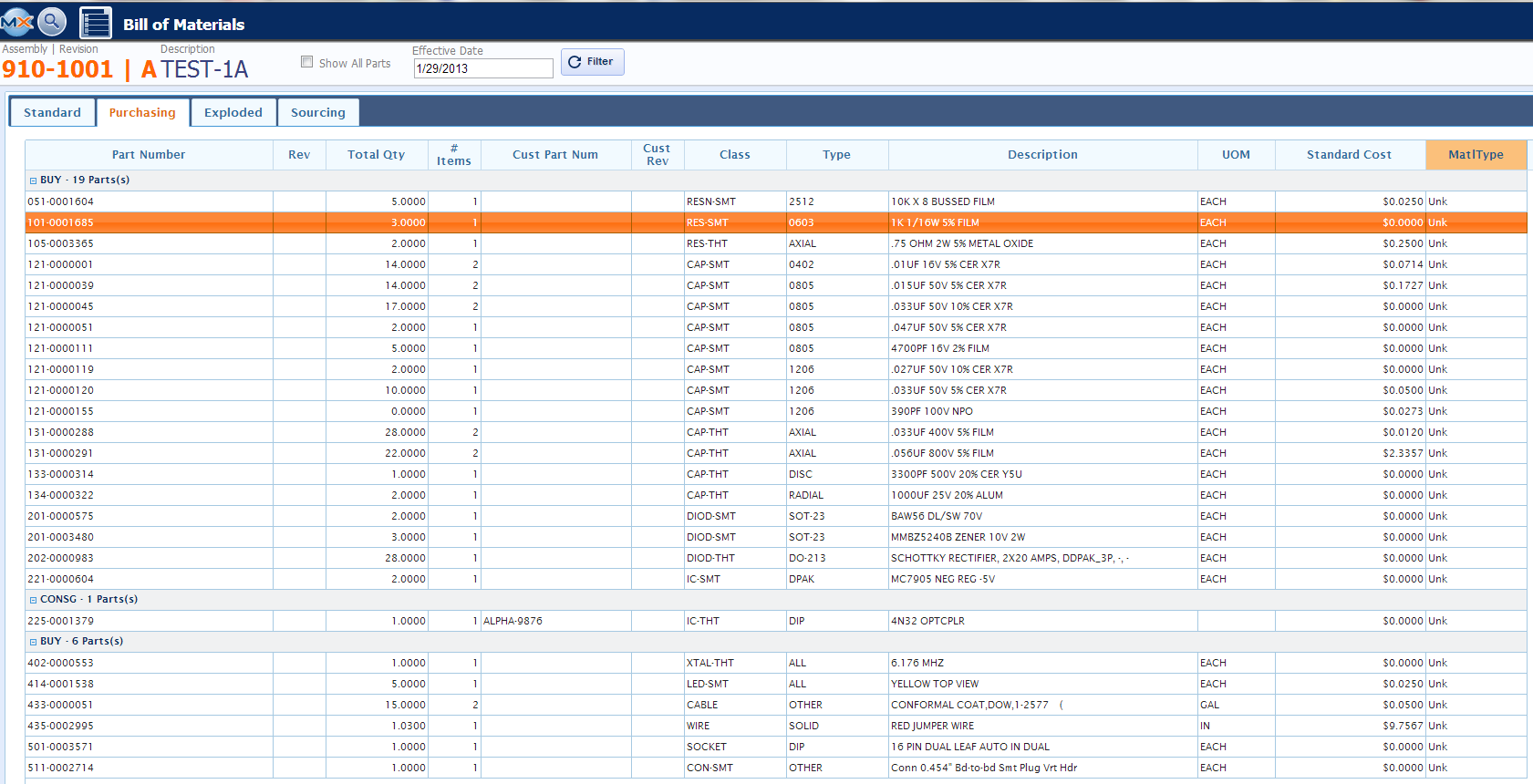 Part Number - The components internal Manex part number
Rev - The Part Number Revision for the component. A component may exist under multiple revisions. Each Rev. is considered a unique part number and may co-exist with other Revs. or replace other Revs
Total Qty - The quantity of the component part used in the assembly. This qty does NOT compensate for setup and run losses; The Setup % and Run Qty fields in the Item Master screen cover production losses
# Items - The item number assigned to the components in the BOM
Cust Part Num - The number the customer uses to identify the part.
Cust Rev - The Part Number Revision for the component. A component may exist under multiple revisions. Each Rev. is considered a unique part number and may co-exist with other Revs. or replace other Revs
Class - The Part Class of the component part as assigned in the Item Master
Type - The Part Type of the component part as assigned in the Item Master
Description - The Item Master description of the component part
UOM - The stocking/kitting unit of measure for the part
Standard Cost - The STANDARD COST of an item is a calculated value determined by the sum of individual costs. These individual costs may be in any combination of the Material, Labor, Overhead, Other and User Defined costs
MatlType - AVL Material Type Code. LF, LF-Date, LF-Mark, LF-P/N, RoHS, RoHS-Date, RoHS-Mark, RoHS-P/N, and Unk are the AVL Material types that are hard-coded into the system.
LF (Lead-Free), RoHS (the restriction of the use of certain hazardous substances in electrical and electronic equipment) or (In general, RoHS requirements include limitations on other heavy metals in addition to being lead free. But many companies may not meet the full requirements of RoHS, but still want to identify the material as Lead Free(, and Unk (Unknown) are the Inventory Material Types that are hard-coded into the system. Then sometimes the user wishes to identify a date code, marking or part number which designates that the part has switched from unknown to LF or RoHS, and that is what the additional modifier is for. Bill of Material - Exploded
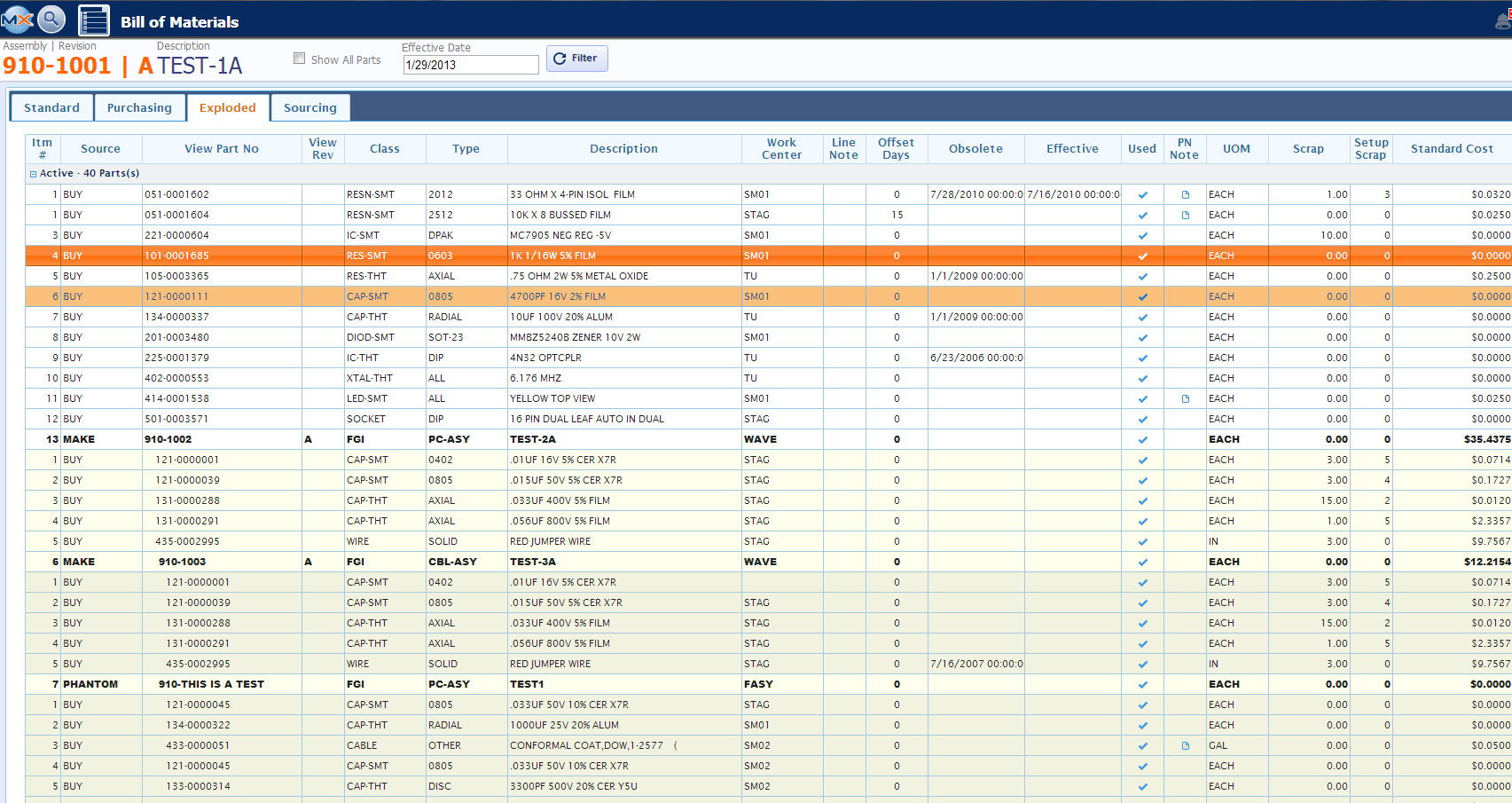 Itm # - The item numbers assigned to the components in the BOM
Source - The sources of the assembly components. Select Make, Buy, Consigned or Phantom
View Part No - The components internal Manex part number. Depressing this button will display BOM Details, Item Master Custom Fields, AVL Configurations, and Ref Designators for selected part
View Rev - The Part Number Revision for the component. A component may exist under multiple revisions. Each Rev. is considered a unique part number and may co-exist with other Revs. or replace other Revs
Class - The Part Class of the component part as assigned in the Item Master
Type - The Part Type of the component part as assigned in the Item Master
Description - The Item Master description of the component part
Work Center - The work center identified in the routing for the assembly at which the part is needed. Kitting of the part by work center will use this information to determine which parts are to be kitted for each work center
Line Note -
Offset Days - - Production offset is a BoM item level field that allows users to control delivery dates in relation to the starting date of the work order. By using this field, the user may move the material requirement date by the specified number of days in either direction
Obsolete - The date the part is no longer required on the BOM for new work orders and the demands will NOT be displayed in MRP
Effective - -This is the date that the part is added and/or removed from the BOM and the demands will be displayed in MRP. MRP picks up all the records with an effective date earlier or equal to current date, and all NULL/BLANK effective dates
Used - Identifies the part as requiring kitting from the storeroom. Typical Non-kitted items include chemicals and adhesives that are re-issued when they run low but are included on the BOM for costing or reference
PN Note - Depressing this button will display BOM Details, Item Master Custom Fields, AVL Configurations, and Ref Designators for selected part
UOM - The stocking/kitting unit of measure for the part.
Scrap - This amount is added to the exact quantity used on an assembly to provide an overage to cover losses during running due to predictable machine and human losses
Setup Scrap - Setup losses may be added to the BOM requirement and Run Scrap for an item.For instance, an auto-insertion machine may use extra parts for alignment checks
Standard Cost - The STANDARD COST of an item is a calculated value determined by the sum of individual costs. These individual costs may be in any combination of the Material, Labor, Overhead, Other and User Defined costs.
Bill of Material - Sourcing
 Source - The sources of the assembly components. Select Make, Buy, Consigned or Phantom
View Part No - The components internal Manex part number. Depressing this button will display BOM Details, Item Master Custom Fields, AVL Configurations, and Ref Designators for selected part
View Rev - The Part Number Revision for the component. A component may exist under multiple revisions. Each Rev. is considered a unique part number and may co-exist with other Revs. or replace other Revs
Class - The Part Class of the component part as assigned in the Item Master
Type - The Part Type of the component part as assigned in the Item Master
Description - The Item Master description of the component part
UOM - The stocking/kitting unit of measure for the part
Standard Cost - The STANDARD COST of an item is a calculated value determined by the sum of individual costs. These individual costs may be in any combination of the Material, Labor, Overhead, Other and User Defined costs.
Part Mfr - Is the name of the manufacturer of this part
MfrPartNo - Displays the Mfg. Part Number for an existing highlighted Mfg
Last Sup - Last Supplier used.
Most Sup - Supplier Most Used.
|
| 1.1.3. How To |
| 1.1.3.1. Find and View a Bill of Material | ||||
Login to the WebManEx and Select Product Data Management
Select the Bill of Materials Icon and the following find screen will be displayed:
Select Bill of Material from this screen and ALL then depress the "Go" button and a Listing of Part Numbers will be displayed:
 Double Click on a Part Number and the Bill of Material for this Part will be displayed. This screen will display all Active parts, Buy, Consigned, Make, and Phantoms.
User may drill down to see more detail per part by:
There are four tabs available. Each tab will display different information for the items listed in this Bill of Material.
The first tab is the Standard Tab - this tab will display all the active parts for this BOM, the Item #, Source, Part Number, Rev, Description, Cust Part Num, Reg, Class, Type, Qty per assembly, UOM, Work Centers, Offset days (if applicable), If used in kit, Effectively, and Obsolete Dates.  The second tab is the Purchasing Tab - this tab displays the Buy and Consgined parts listed on the BOM, Part Number, Total Qty per assembly, Item #, Customer Part Number (if applicable), Class, Type, Description, UOM, Standard Cost, and Matl Type.
 The third tab is the Exploded Tab - this tab will explode out any Sub Assemblies, Make or Phantom Assemblies listed on the original BOM, along with the Part Numbers, Class, Type, Description, Work Center, Line Notes, Offset Days, Obsolete and Effective dates, Used on BOM, PN Notes, UOM, Scrap and Setup Scrap and Standard Cost.
 The fourth tab is the Sourcing Tab - This tab will display the Buy and Consigned parts or parts that will be sourced out to Suppliers. This tab will list the Source, Part Number, Class, Type, Description, UOM, Standard Cost, Part Mfgr and Mfgr Part No, Last Supplier used and Supplier Most used.
 On any of the tabs if user want to view more detail for a specific part, such as the AVL information, or Reference Designators,or add any BOM or Item Master Detail:

All standard grid customizations apply. See related Article for more information. |
| 1.2. BOM Reports |
| 1.2.1. BOM Report FAQ |
|
| 1.2.1.1. Why am I seeing a difference in total cost on the "BOM indented and costed report" in SQL compared to the VFP version? |
Q:Why am I seeing a difference in total cost on the "BOM indented and costed report" in SQL compared to the VFP version? A: In VFP the report used to include the Std Cost value for the Make/Buy itself and then also explode out the components for Make/Buy sub-assembly (which was incorrect) In SQL the report will take the std cost for the Make/Buy and not include the components. |
| 1.2.2. Introduction |
|
ADDRESS {rootURL} BOM
NOTE: {rootURL} is the URL you use to access web ManEx
From this screen, the user can:
|
| 1.2.3. How To |
All Reports are found within the Report Manager and are basically viewed the same. See Article 5477 for further detail on Reports.
|
| 1.3. BOM Import |
| 1.3.1. Prerequisites |
To import a BOM, one of the templates below must be used.
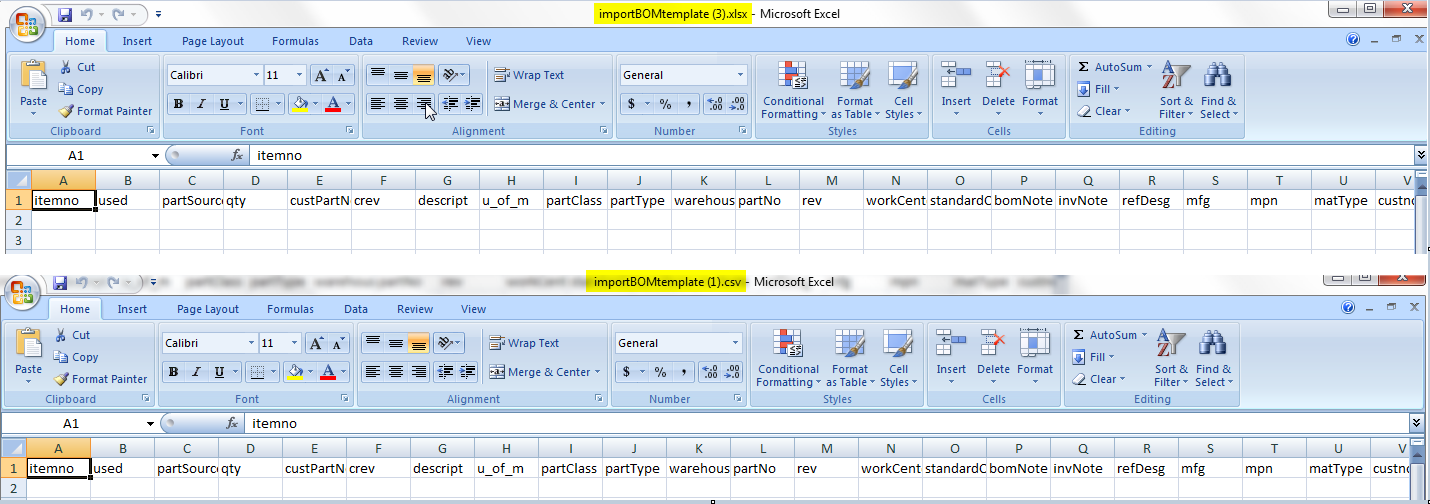 It is okay if you have blank lines, but they should be subsequent lines of the same assembly, NOT the first line item no. First priority is the assynum and rev columns in the spreadsheet,. If you populate that data, in the first item number it will use that as the import record assembly number. NOTE: If you are entering parts for different customers on the same spreadsheet you MUST enter different assynum and/or rev to distinguish between customer parts. If assynum is same it will override customer number and use prior customer linked to that assembly number.
If the assynum and rev columns are blank in the first item no (as in item 1 in this bom) THEN the import will use the file name as the assembly number, then, if the rest of the line items have data that is the same, the system will put it on another import record with the listed number.
Font size: We made it larger so it is easier to read and use on things like a tablet. However, if your screen size is small it may appear too large. |
| 1.3.2. Introduction |
|
ADDRESS {rootURL} BOM
NOTE: {rootURL} is the URL you use to access web ManEx
AVAILABLE ACTIONS From this screen, the user can:
|
| 1.3.3. Fields and Definitions |
| 1.3.3.1. BOM Import Templates | |||||||||||||||||||||||||||||||||||||||||||||||||||||||||||||||||||||||||||||||||||

|
| 1.3.3.2. Import Screen |

|
| 1.3.3.3. Upload Screen | ||||||||||||||||||||||||||||||||||||||||||||||||||||||||||||||||||||||||||||
This header will be displayed throughout the WebManEx. For further detail on the header icons see Article #5292.
Depressing the "MX" icon
at the top left hand corner of the screen will list the ManEx modules available.
Depressing the "Magnifying Glass" Icon at the top left hand corner of the screen will give the user all the different option to find a record. Depressing on the "Up Arrow" Icon will give the user the opportunity to Change from "New" or "Reports". Depressing on the "Bell" Icon will display a list of BOM Imports that have been started. Depressing the "Clock" Icon will allow you to clock into a Job or Work Order.
If you attempted to create a new import for the exact same assembly and rev that already exists in the Notifications. The following message will be displayed.
This is to prevent users from accidentally working on multiple versions of the same record and wondering why their last changes weren't sticking, we automatically redirect you to the existing active import. Once you transfer the bom, you can start a new one for the same bom. Or, you can change the part number or rev in order for it to be treated as a new import. Or, you can delete the current active record to start fresh. NOTE: The import in process will NOT exist in the desktop. You must first transfer it in order to see the parts and changes. The "EXISTING ACTIVE IMPORT" is just an import that you can finish and transfer in order to see it in the desktop.  This header will display the Assembly/Rev.; Description; Customer; Part Class; Part Type; for the BOM Upload, along with the Date/Time the Upload was started and the initials of the user that started the upload.
This header has the following action icons:
Select the "Validate" button and the Validation screen will appear validating the information entered.
Note: During the Validated processes if the system finds errors these fields will be shaded in Red indicating that these fields have missing or incorrect information. Select the "ShowKey" This screen will display what the field colors stand for:
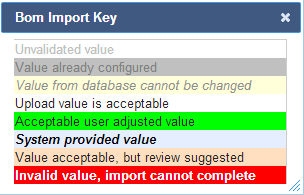  The Red Note Pad (to the right) will display notes pertaining to this BOM Import and allow user to add or edit the notes.
 Depress the Filter in the left hand corner of the screen to change how the notes are being filtered:
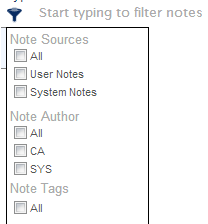 Flag - on top left of note screen is to Flag the Note.
Clipboard - on top left of note screen is to copy Note to Clipboard.
Tag - on top left of note screen is to Add a Tag to Note.
Trash Can - on top right of note screen is to Delete Note.
Pencil - on top right of note screen is to Edit Note.
Plus Sign - on top right of note screen is to Add new Note.
The "Plus sign" on the top right of BOM Import header is to add a new item to BOM Import.
The "Import Parts" button on top right of BOM Import header is to import BOM to desktop.
The "Trash Can" on the top right of BOM Import header is to delete BOM Import completely.

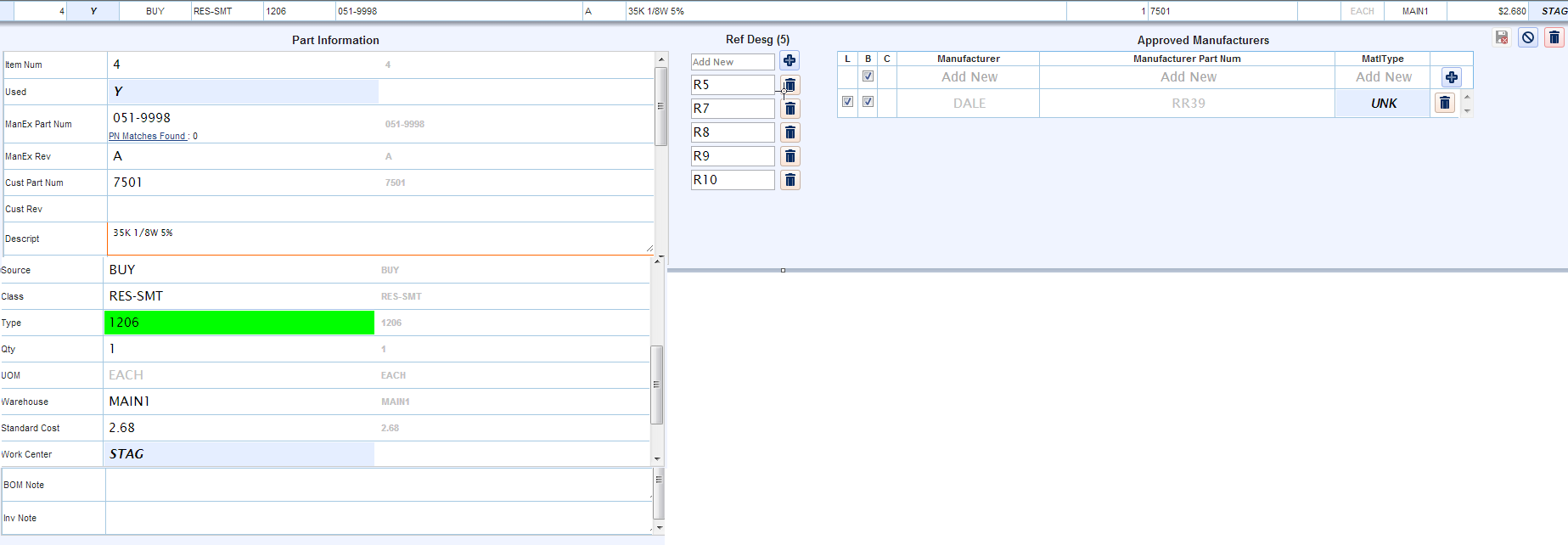 Part Information
Note: The data to the right in gray is the data that was imported originally.
Approved Manufacturers
|
| 1.3.4. How To |
| 1.3.4.1. Find a BOM Import that has Already Been Started |
Login to the WebManEx and Select Product Data Management Select Import and the following screen will be displayed
 Click on the Bell symbol (with the number 4 by it) up in the right hand corner and a list of Notifications will be displayed of all the Import Started:
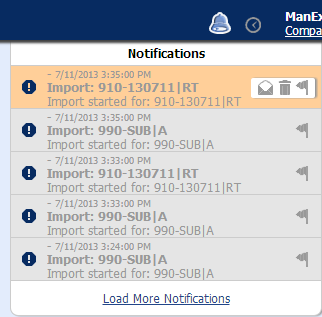 Highlight the Import of interest and the following screen will be displayed:
 Depress "Click Here" and the import will be displayed on screen:
 If you attempted to create a new import for the exact same assembly and rev that already exists in the Notifications. The following message will be displayed.
This is to prevent users from accidentally working on multiple versions of the same record and wondering why their last changes weren't sticking, we automatically redirect you to the existing active import. Once you transfer the bom, you can start a new one for the same bom. Or, you can change the part number or rev in order for it to be treated as a new import. Or, you can delete the current active record to start fresh. NOTE: The import in process will NOT exist in the desktop. You must first transfer it in order to see the parts and changes. The "EXISTING ACTIVE IMPORT" is just an import that you can finish and transfer in order to see it in the desktop.
|
| 1.3.4.2. Import BOM |
User MUST first download a blank template and enter the BOM information into the template.
System will look at the Item Number and Description to determine whether it is a different part, if the Item Number and description match then the Shaded parts do NOT have to be populated. The information from the previous lines will be used, when creating the BOM import. If the assynum, assyrev, and assydesc fields are all blank on the first line item, system will use the File Name as the Assembly Number. for further detail see Article 5490. Once the template has been completed with all the BOM information, save the file. Login to the WebManEx and Select Product Data Management Select Import and the following screen will be displayed
 Enter the file name in the field or depress the "Browse" button to locate the file to import.
Once the file has been selected it will be displayed in the Field as displayed below:
Depress the "Upload Button" If you attempted to create a new import for the exact same assembly and rev that already exists in the Notifications. The following message will be displayed.
This is to prevent users from accidentally working on multiple versions of the same record and wondering why their last changes weren't sticking, we automatically redirect you to the existing active import. Once you transfer the bom, you can start a new one for the same bom. Or, you can change the part number or rev in order for it to be treated as a new import. Or, you can delete the current active record to start fresh. NOTE: The import in process will NOT exist in the desktop. You must first transfer it in order to see the parts and changes. The "EXISTING ACTIVE IMPORT" is just an import that you can finish and transfer in order to see it in the desktop. Depress the "Upload" button and the data will be Uploaded into the following screen and Validated.  During the Validated processes if the system finds errors these fields will be shaded in Red indicating that these fields have missing or incorrect information.
Click on an item and all the detail for that item will be displayed. User may make changes/corrections to any of the Part Information, Ref Desg, Manufacturer, Manufacturer Part Numbers, and Material Types. The fields shaded in Red indicates that the information is incorrect or missing and must be corrected before the import process can take place.
 The data to the right on the Part Information screen that is light gray is what was imported from the template.
The Class and Type will have a pull down to select from:
 Clicking on the magnifying glass to the right of the ManEx Part Number will do a search to located any existing parts that are similar to the one entered:
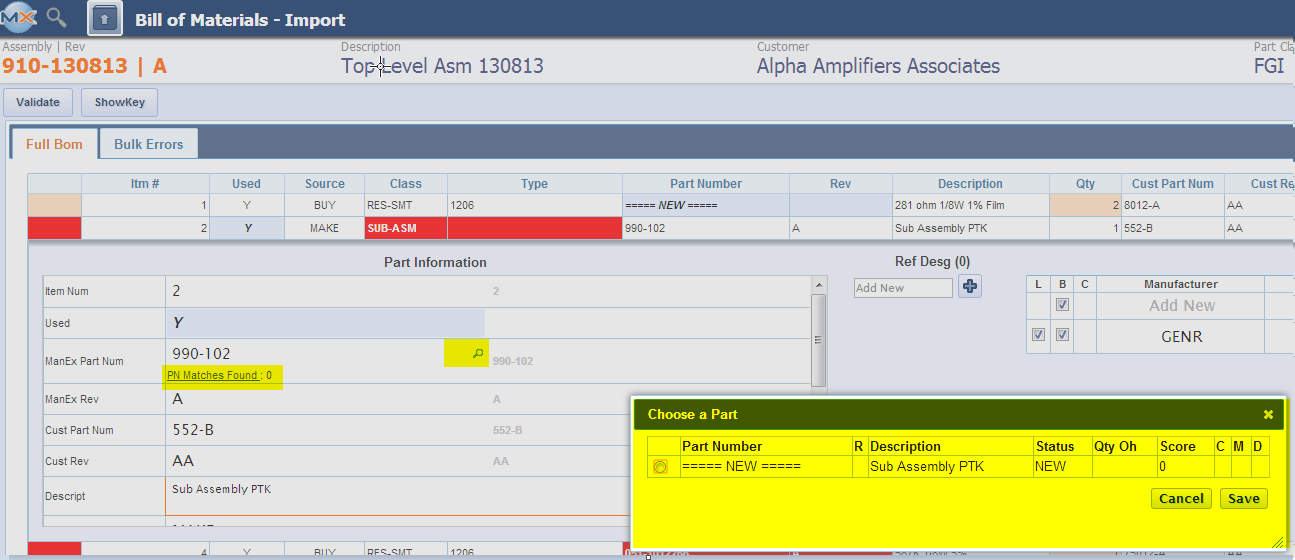 NOTE: If user has Inventory Part Numbering setup to MANUAL, user has the option to enter a part number in the ManEx Part Num field, or if a ManEx part number exists for the part being imported user may use the existing ManEx part number, but if user does NOT want to use the existing ManEx PN, they MUST select "NEW" and then enter in the part number they want to use. If they have Inventory Part Numbering setup to AUTO then they MUST select an existing PN or have "NEW" in this field, and a part number will be assigned to this part upon import.
User may add Reference Designators by clicking on the (+). The number of Ref Desg needed for this part will be displayed in (). To remove an existing reference designator click on the (garbage can symbol) to the right of the desg you want to remove, click on the (Undo) to restore the reference designator you removed.
You need to save changes before you can add additional reference designators if you do not (Undo) any of the ones you deleted. If a user adds more ref desg then required at time of upload it will only use the number of ref desg required starting from the top of the list down.
To add a New Mfgr, depress the (+) button on the right and new fields will be displayed in green:
 Enter Mfgr, Mfgr PN, and select a new MatlType or leave the default (Unk). Once all the changes have been completed and there are no more fields shaded in RED, depress the "Save & Exit" button, "Cancel" button, or "Delete" button.
 If users changes the Manufacturer or Manufacturer Part Num then hovers over that field the Mfgr or Mfgr PN originally uploaded will be displayed in gray and the new Mfgr or Mfgr PN will be displayed in black and will be bordered in RED on three sides as displayed below.
 Select the "Validate" button to validate all changes.
Once all the data is correct, user then may select the "Import Parts" button to load the BOM into the ManEx system.
 If the BOM has already been loaded to ManEx user will receive the following message giving the user the option to reimport this BOM.
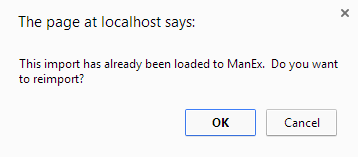 If user is trying to Import Parts with Errors the following message will be displayed, giving the user the option to continue with errors or cancel import:
 Once the BOM has been loaded to ManEx the Header will turn from White to Gray as displayed below:

|
| 1.3.5. Limitations to the Reference Designators |
| 1.3.6. Limitations to the Different Import Template Types |
Assembly Info
Template TypesThe following explains the different limitations to the different Import Template Types that are available in the WebManEx
.XML Map for Excel:
.CSV Template:
.XLSX Template:
.XLS:
|
| 1.3.7. BOM Import - FAQ |
| 1.3.7.1. What do the BOM import settings do? | ||
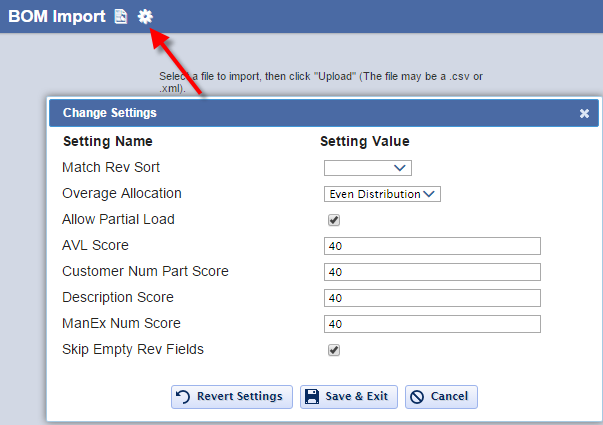 |
| 1.3.7.2. How do I Remove Duplicate AVL's? |
| If a user sees duplicate AVL's in the BOM import list of parts then it means somehow they were able to get a duplicate manufacturer in the database. We have a built in SP (dbo.InvtMpnCleanRefresh) to clear that.
It is attached to this article as well.
|
| 1.3.7.3. Receiving primary Key violation error upon import. What does it mean? |
Upon import you may be presented with something similar to the error in image below. Typically means on your import template for this BOM you have the same Manufacturer and MPN combination listed more than once when creating a brand new part. Typically won't see this when system matches to existing part #'s.
|
| 1.3.8. BOM Import Settings | ||
|
